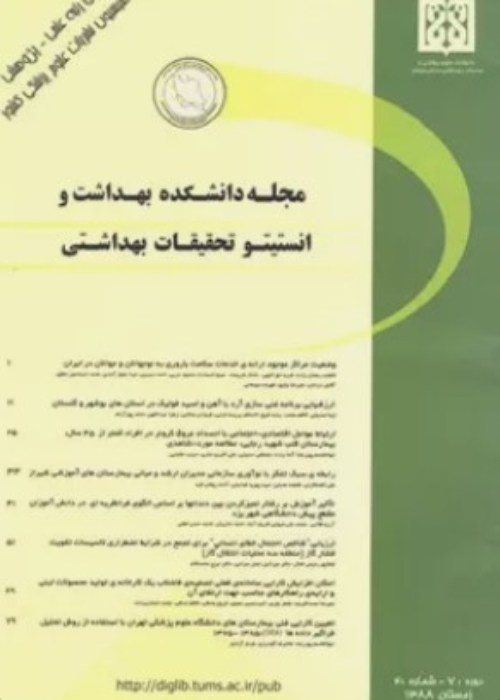The Distribution of Hard Ticks as a Vector of Crimean-Congo Hemorrhagic Fever in the Border Areas in the North West of Iran
Author(s):
Article Type:
Research/Original Article (دارای رتبه معتبر)
Abstract:
Background and Aim
Ixodidae (hard ticks) are obligate blood-feeders of vertebrates with major roles in transmission of pathogenic microorganisms including theileriosis, babesiosis and CCHF virus, as well as relapsing fever, to domestic animals and humans. This study was conducted to determine the distribution of ixodidae species, vectors of Crimean-Congo hemorrhagic fever (CCHF), in the border areas in North West of Iran.
Materials and Methods
This was a descriptive cross-sectional study conducted in Ahar and Kaliybar Counties, East Azarbaijan Province, Iran. Randomized cluster sampling was done in villages in the forest and mountainous regions. Ticks were isolated by forceps from the animals, kept in sampling tubes and transferred to the laboratory. Then the tick samples were identified using taxonomical keys.
Results
A total of 2022 hard ticks were isolated from 1400 head of livestock (1000, 200, 180 and 20 head of sheep, goat, cow and buffalo, respectively). On the average, the infestation rate was 1.44 per head of cattle ─ 0.11% in goats, 0.32% in sheep, 0.90% in buffaloes, 9.25% cows. Out of the ticks isolated, 498 (24.63%) were male, 741 (36.65%) were female and 782 (38.67%) nymph, plus one larva. The ticks belonged to the lxodidae family, including four genera: Hyalomma (88.82%, with the following three species: Hyalommaanatolicum (39.22%), Hyalommamarginatum (9.15%) and Hyalommaasiaticum (0.69%)); Rhipicephalus (8.8%); Dermasentor (1.58%); and Haemaphisalis (0.8%). The others identified were Hyalomma nymph (38.67%), Hyalomma sp. (1.04%) and Hyalomma larva (0.05%), Rhipicephalus bursa (5.19%), Rhipicephalussanguineus (3.61%), Dermasentor marinates(1.58%), Haemaphisalissulcata (0.59%), and Haemaphisalispunctata (0.15%), as well as Haemaphisalisconcinae (0.05%). Hyalommaanatolicum was the dominant species.
Conclusion
The dominant tick species in the regions studied was Hyalommaanatolicum, a tick having a major role in transmission of many disease vectors including CCHF, ovin babesiosis, theileriosis, anaplasmosis, ehrlichiosis, etc. It is essential that the provincial Contagious Disease Center and Veterinary Department take appropriate action with the collaboration of other relevant departments to combat the tick.Keywords:
Language:
Persian
Published:
Scientific Journal of School of Public Health and Institute of Public Health Research, Volume:17 Issue: 1, 2019
Pages:
71 to 82
magiran.com/p1995437
دانلود و مطالعه متن این مقاله با یکی از روشهای زیر امکان پذیر است:
اشتراک شخصی
با عضویت و پرداخت آنلاین حق اشتراک یکساله به مبلغ 1,390,000ريال میتوانید 70 عنوان مطلب دانلود کنید!
اشتراک سازمانی
به کتابخانه دانشگاه یا محل کار خود پیشنهاد کنید تا اشتراک سازمانی این پایگاه را برای دسترسی نامحدود همه کاربران به متن مطالب تهیه نمایند!
توجه!
- حق عضویت دریافتی صرف حمایت از نشریات عضو و نگهداری، تکمیل و توسعه مگیران میشود.
- پرداخت حق اشتراک و دانلود مقالات اجازه بازنشر آن در سایر رسانههای چاپی و دیجیتال را به کاربر نمیدهد.
دسترسی سراسری کاربران دانشگاه پیام نور!
اعضای هیئت علمی و دانشجویان دانشگاه پیام نور در سراسر کشور، در صورت ثبت نام با ایمیل دانشگاهی، تا پایان فروردین ماه 1403 به مقالات سایت دسترسی خواهند داشت!
In order to view content subscription is required
Personal subscription
Subscribe magiran.com for 70 € euros via PayPal and download 70 articles during a year.
Organization subscription
Please contact us to subscribe your university or library for unlimited access!



